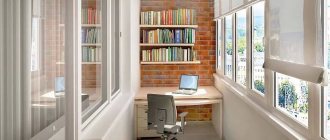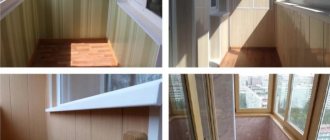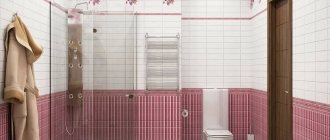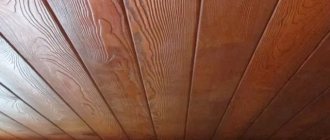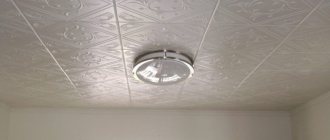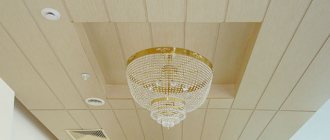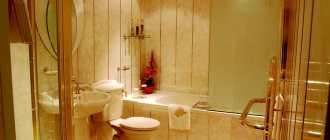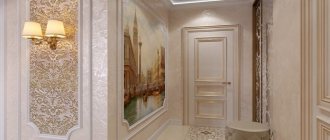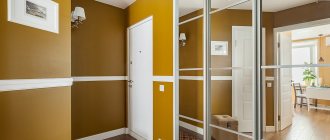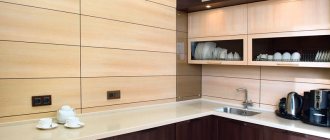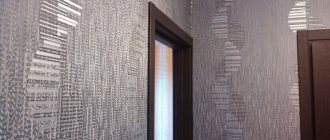The walls in the hallway, especially if there are small children or pets in the house, are subject to various damages and dirt much more than in other rooms. That is why finishing materials for the hallway and corridor must be chosen with special care, because this part of the house is the first thing that visiting guests see.
There are a lot of finishing materials that can be used in such cases, and each of them has its own advantages and disadvantages.
Plastic panels
Panels made from polyvinyl chloride are an artificial material that does not contain cadmium or asbestos. Due to their cellular structure, they are ideal in situations where high-quality sound insulation is required.
Among the main advantages of plastic panels are the following:
- a huge selection of colors and patterns;
- the presence of a protective coating that provides good resistance to sunlight;
- Possibility of use in rooms with high humidity levels;
- ease of care;
However, given that the material is artificial, such panels are not recommended for use in finishing residential premises.
Finishing the hallway - 8 of the most interesting and practical ideas
Recently, the choice of finishing materials that can be used in the hallway has increased greatly. In particular, options such as decorating the hallway with decorative stone or plastic panels have become popular. To help you choose, below we will consider some of the most interesting and practical ideas.
An example of a successful hallway decoration
MDF Corridor Wall Panels
In the manufacture of MDF panels, fine shavings and wood dust are used, which are compressed at high temperature and high pressure.
The panels, whose thickness reaches 16 millimeters, look like wood.
The advantages of MDF panels include:
- reliable and strong, yet easy to cut;
- increase heat and sound insulation;
- on sale you can find panels with moisture-repellent and fire-resistant impregnation;
- can be used to decorate any room, but they look best in the hallway and corridor.
Design options
Those who think that wall panels look boring and cheap are very mistaken. Modern industry offers such an abundance of options that you can choose an original solution for any interior style - from timeless classics to defiant abstractionism.
At the same time, the interior of the hallway with panels can be completely filled (all walls are “dressed” in panels) or partially. The so-called decorative option is common, when coverings are laid out in separate elements without performing a particular practical function.
Natural wood panels
In the manufacture of such panels, hardwood and wood with natural wood veneer are used. The main materials are: alder, cedar, oak, ash, pine, beech and maple.
After the panels are made, they are impregnated with special compounds to make the material resistant to moisture and fire.
- The veneer panel includes several layers. The main layer is made of pine, the cheapest material. Then a two or three-layer veneer is glued to it, on top of which the final one (made of valuable wood) is glued.
- The layers are bonded to each other through hot pressing.
- Finally, the panel is thoroughly polished and then covered with varnish, paint or wax.
The most expensive panels are made exclusively from valuable wood, with further polishing.
Materials, their pros and cons
Each of the materials that can be used to decorate the corridor has its own disadvantages and advantages - this is a fact.
Plastic panels
Plastic panels for the corridor - a high-quality, viable solution
PVC panels for the hallway (products made of polyvinyl chloride) are a material that is one hundred percent artificial. However, it does not contain cadmium or asbestos - and this is very good from an environmental point of view.
In addition, plastic panels have a cellular structure - this has a very beneficial effect on sound insulation (this is also very important today).
What else can you say about this finishing material? Much:
- The range of designs and colors is quite large. Due to this, you will be able to bring a variety of ideas to life. The photos of the corridor finishing with panels speak for themselves - look at them once and you will understand everything yourself.
- Here is the photo code
- Protective coating available. Thanks to this, the material has impressive resistance to sunlight and UV radiation;
- Finishing a room with panels can be done even where the humidity level is high;
- The surface is easy to keep clean - the panels are very easy to clean and are hygienic;
- It is not recommended to use such material inside residential spaces: this is due to its artificial origin (but PVC panels are ideal for a corridor - that’s a fact).
MDF wall panels for finishing corridors
MDF panels - excellent imitation of natural wood
How are MDF panels made today? For production, wood dust is used, to the composition of which fine shavings are also added. Under great pressure, all this is compressed when exposed to high temperatures.
More information about MDF panels:
- On average, the thickness of such panels is 15 mm - they look very similar to wood;
- Cutting MDF is very simple: they do not crumble or break;
- In a room, such material (if the walls are decorated with it) significantly increases thermal insulation and sound insulation;
- Today on sale you can easily find panels with high moisture resistance. The presence of moisture-resistant impregnation will be indicated by the image of a drop of water (you will need to carefully inspect the packaging);
- Panels are also produced with fire-resistant impregnation - today such properties are highly valued;
- You can use these panels in any room of your apartment. But they will look best in the hallway (or corridor).
Natural wood panels for finishing the corridor
The most expensive option possible: panels made from natural wood
For the production of panels, the most expensive material can be called wood - any hard species. A similar solution in terms of cost can be called wood, which is finished with veneer made from natural wood. People who like to save money prefer to use plastic panels for walls.
What types of trees are used to produce wood trim panels?
- Beech and oak;
- Ash and alder;
- Pine and maple.
In order for such a material (wall panels made of natural wood) to be resistant to fire and moisture, the finished panels must be impregnated with various specialized compounds - otherwise this is not done in our time.
More details about the finishing material:
- If we consider veneered panels, the main layer is made of pine - such wood is considered the cheapest. Veneer is glued to it in two or three layers. The front layer is glued from veneer, which is made from any valuable wood species;
- All these layers are fastened together - for this, hot pressing technology is used;
- Then the panels are usually polished, varnish, paint or wax are applied to them;
- People who are ready to invest a significant amount of money in decorating their corridor can purchase custom-made panels that are made entirely from valuable and hard wood (the material is one hundred percent free from impurities), and then carefully polished.
When entering a house or apartment, panels made from natural wood look very impressive and noble - this is an indisputable fact.
Fiberboard panels for finishing the corridor
In the decoration of the corridor, fiberboard panels are not so rare
Fiberboard panels
The production of fiberboards is carried out by hot pressing of wood fibers, which allows the production of lignin (an organic binder). This completely eliminates the use of synthetic binders during production.
The advantages of fiberboard panels include:
- possibility of use in residential premises, since fiberboard panels are an environmentally friendly material;
- they are moisture resistant, so they can be washed as needed;
- Due to their appearance, such panels are excellent for decorating hallways and corridors.
Variety of wall panels
Today, wall panels for corridors are available in various colors, textures and sizes. In accordance with this, all panels are divided into several more types.
Tile panels
Tile panels are similar in appearance to ceramic tiles, but on the reverse side they have a tongue-and-groove fastening system. Such panels can be used for finishing as the main material or in combination with other types of finishing, creating bright and unusual compositions. They are produced in various colors, often complemented by various finishes.
Slatted panels
In appearance, this material is very similar to the usual lining, but they are also equipped with a tongue-and-groove fastening system, which makes their installation much easier. In most cases, their height reaches from 2.5 to 6 meters, and their width reaches from 10 to 40 centimeters.
Sheet panels
Such panels are made in the form of monolithic homogeneous sheets, additionally decorated with various patterns. They are often used to decorate walls of non-standard sizes. The main distinguishing feature of sheet panels is the ability to install them on a flat wall without additional means.
Rules for choosing wall panels for a corridor
You should choose panels to decorate your corridor based not only on your ideas of beauty, but also on the characteristics of each material. If the front side of the selected panels is covered with wax, this means that the material has good resistance to moisture. However, in corridors, high humidity is not such a common occurrence, so this characteristic can be considered optional.
MDF
MDF panels are very durable, they can significantly increase the level of heat and sound insulation in a room. If they are required for finishing a room in which the air temperature will be high, it is worth immediately noting that in such conditions the material will quickly lose its attractive appearance.
Plastic
PVC corridor wall panels are excellent when the room requires additional sound insulation. They are simply a godsend if you need to implement a design solution, because their finish can be not only matte, but also glossy, cellular, with drawings and patterns. An important advantage is the ease of maintenance, because to clean the panels from dirt, you just need to wash them. Their main disadvantage is the unnaturalness of the material.
Tree
Wood comes first on the list of the most popular materials for wall decoration. The appearance of such panels can make the atmosphere in the house more comfortable, but the material is one of the most expensive.
Chipboard and fibreboard
The main positive feature of this material is its low cost. Perfect for those cases where a simple finish without frills is enough. The downside is considered to be low strength.
Cork
Cork panels are a natural, durable and lightweight material that significantly increases the heat and sound insulation properties of a room. Thanks to their cellular structure, they can become a real decoration of any corridor or hallway.
Wall decoration
First of all, I will give options for wall decoration, since it is the choice of wall materials that usually raises the most questions. Of course, in principle, absolutely any covering can be used in the hallway. However, it should be borne in mind that the surfaces in this room are more susceptible to contamination than in other rooms, which is due to the increased traffic here and the proximity to the street .
Therefore, when choosing what to decorate the walls in the hallway with, you must take into account that the materials must meet the following requirements:
- abrasion resistance;
- moisture resistance;
- possibility of wet cleaning;
- resistance to temperature changes.
The following materials meet these requirements:
Types of materials for decorating walls in the hallway
Below we will take a closer look at all these coating options.
Option 1: decorative stone
Fans of original hallway design can be recommended to decorate the walls with wild stone or its artificial equivalent. True, the cost of this coating is quite high, so most often it is combined with other materials, for example, wallpaper or plaster .
Among the advantages of decorative stone, the following points can be highlighted:
